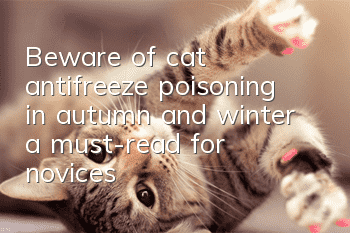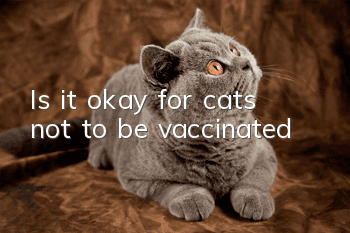Beware of cat antifreeze poisoning in autumn and winter, a must-read for novices!

Antifreeze can poison cats
Beware of antifreeze poisoning in cats during autumn and winter, a must-read for beginners! Autumn and winter are here, and people in the Northeast may add or replace antifreeze in their motorcycles to help survive the winter. . Ethylene Glycol is the main component of antifreeze. It tastes sweet but is highly toxic. Ingestion of a small amount can cause coma or even acute renal failure in small animals. If your cat accidentally eats it, parents are asked to take it to the veterinarian quickly for treatment. Ingestion of antifreeze is an emergency. If it is not treated in time, the cat’s life may not be saved.
Because antifreeze has a sweet taste, pets like the taste very much, but cats will be poisoned and die if they drink antifreeze. Antifreeze is traditionally made from ethylene glycol, a highly toxic substance that when digested turns into oxalic acid, which can damage an animal's kidneys and cause kidney failure and death. Due to the potential toxicity of ethylene glycol, manufacturers have begun using propylene glycol instead of ethylene glycol to make antifreeze.
Low Tox brand products produced by American Preston Company and Sierra brand products produced by Safe Brands Company are considered harmless to pets and children. Although these products are often labeled "harmless" or "nontoxic," unfortunately, no matter how formulated antifreeze is, it is never completely nontoxic. Antifreeze made with propylene glycol is relatively safe because humans or animals need to ingest a larger amount to be poisoned, but if a sufficient amount is ingested, it can still cause poisoning or even death. Caution is the best policy when handling antifreeze. Cleaning up any antifreeze spills promptly and keeping them out of reach of your cat is the best way to protect your pet from harm, no matter what brand of antifreeze you use.
1. Symptoms of ethylene glycol poisoning
In the first 12 hours after ingesting ethylene glycol, small animals will drink unusually large amounts of of water. They may experience "drunk" symptoms, and in severe cases, they may experience epilepsy (convulsions) or even coma.
Within 12-24 hours after ingesting ethylene glycol, the apparent "drunk" state may disappear, and everyone may feel that things are developing in a better direction. However, the glyoxylic acid in the body is slowly decreasing Hoarding, acidosis is obvious. At this time, small animals may have accelerated heartbeats and breathing, or may become dehydrated.
Cats will develop symptoms of kidney failure due to the formation of calcium oxalate crystals within 12-24 hours of accidentally ingesting ethylene glycol, including depression, loss of appetite, vomiting, and reduced urine output.
2. Treatment methods
There are only two solutions to treat ethylene glycol poisoning: ethanol or 4-MP (fomepizole, fomepizole). The focus of treatment is to promptly stop the metabolites such as glycolic acid and glyoxylic acid formed in the body to avoid the formation of calcium oxalate crystals. Therefore, cats mustTreatment is required, and if treatment is delayed, these medications will not help. Although the time period is slightly longer, the earlier the treatment, the better the prognosis.
In addition, there are some specific medicines for antifreeze poisoning such as vodka. This cat named Missey was brutally doused with antifreeze by a group of people outside their house. The family found out and immediately sent the cat to the veterinary hospital. The doctor told owner Paul Stephenson and his daughter Sara that vodka could be used to detoxify the cat. Doctors injected vodka into the cat's body through an intravenous drip, and the strange treatment finally worked.
Sara said: When we heard about this treatment, I was very surprised. I had no idea that vodka could be used to treat animals. Missey was completely drunk and had been treated for two days with 0.5 liters of 37.9% vodka. It wanted to stand up, but it couldn't walk smoothly and fell down. Its eyes were dull. It even tried to grab a pen at one point, but couldn't. The drunk cat first went to White Cross Veterinary Hospital in Redcar, England, and is now under 24-hour observation at Vets Now Hospital in Middlesbrough. Andrew Miller, a doctor from White Cross, said: "This vodka treatment is very special, but it is a common method for animals that accidentally eat antifreeze. Because of the intravenous injection, they will become very drunk, and the main effect is The ingredient is ethanol. Antifreeze is very toxic to the kidneys of animals. We specifically chose to use vodka because the ethanol in it can neutralize the toxic substances in the antifreeze."
He added: " Antifreeze is very toxic to animals and is life-threatening. Sadly, not all the animals we treat who accidentally eat antifreeze survive. However, as long as they are treated in time and vodka is used to react with the antifreeze in the body, they can survive. The probability is very high."
To sum up, antifreeze is delicious to small animals, but ingesting a small amount can cause irreparable consequences. One teaspoon (1 teaspoon=5ml) of antifreeze can kill a cat. If you suspect that your little one has swallowed antifreeze under the car in the garage, be sure to take it to the veterinarian for a checkup! Your veterinarian can confirm the diagnosis with a blood test, but the sooner you treat ethylene glycol poisoning, the better the outcome.
- Popular science on the diagnosis and treatment of feline joint disease, a must-read for cat owners!
- Are Siamese cats easy to raise?
- Can cats eat dog food?
- How long can a cat go without food?
- Can stray cats eat sugar oranges?
- The cat foamed at the mouth while chewing
- What should you pay attention to when feeding honey water to cats?
- Cat lies on owner's chest and purrs while sleeping
- How many times a week should a cat eat canned food?
- How to deal with a cat in a new environment



